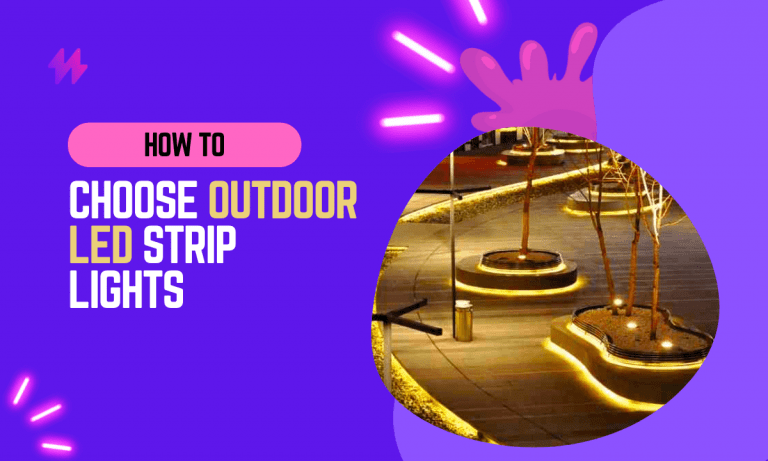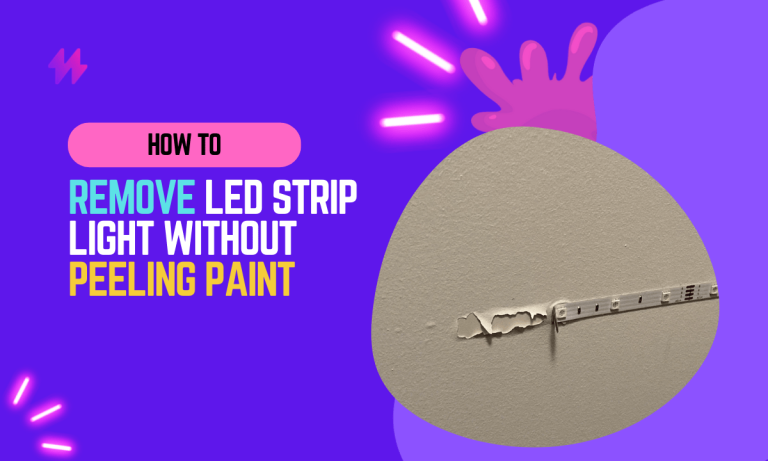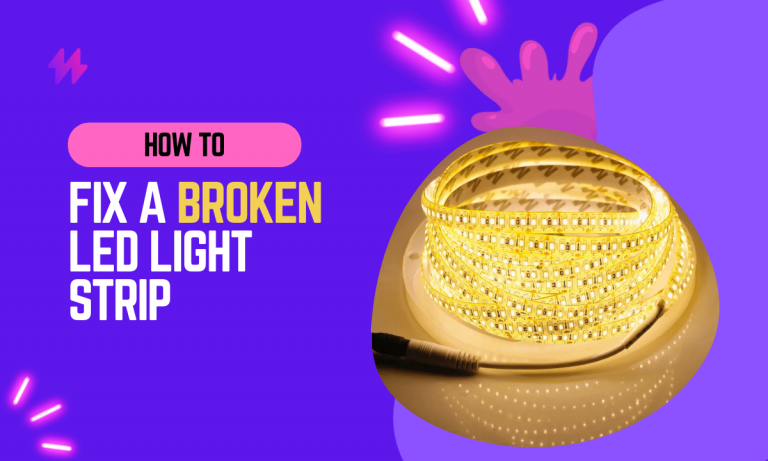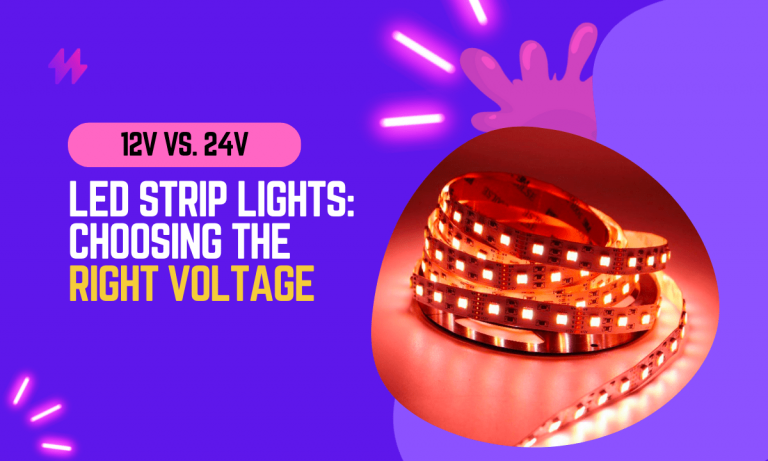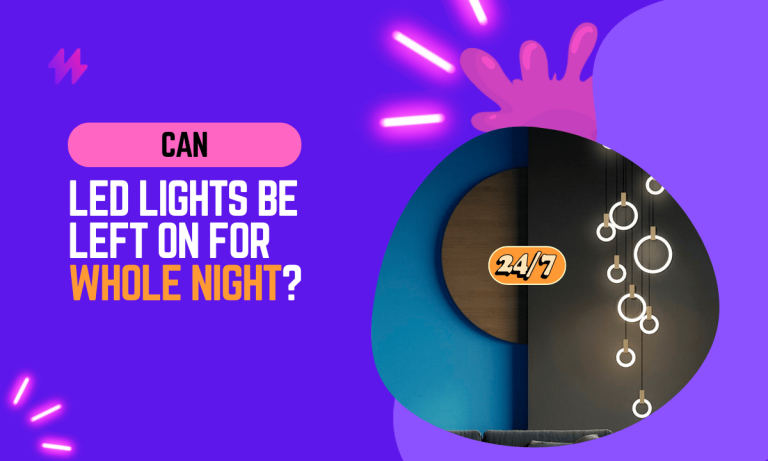What is the Width Size of LED Light Strip?
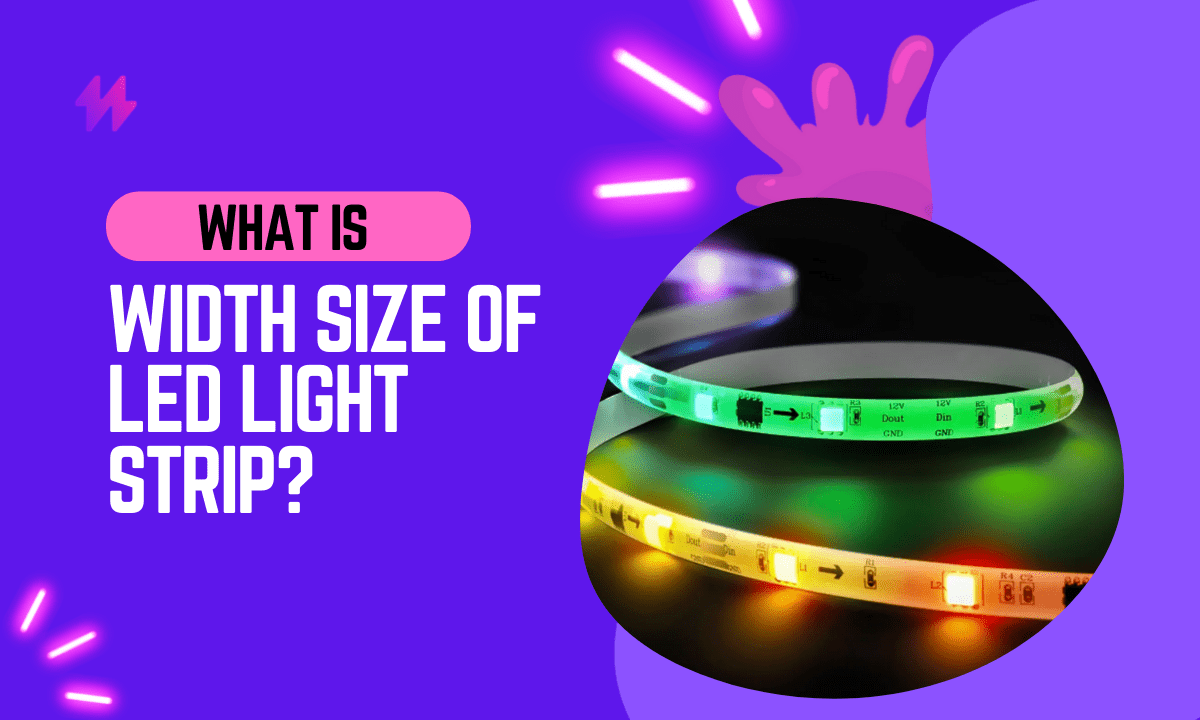
LED light strips are a flexible lighting solution that can be used for a variety of applications in the home. They consist of a series of small light-emitting diode (LED) bulbs mounted on a flexible strip of plastic or other material. The strips can be cut to size and are often used for accent lighting, task lighting, or ambient lighting.
LED strip lights come in a variety of widths, making them a versatile option for both residential and commercial use.
One important factor to consider when choosing an LED light strip is the width size. The width of an LED light strip refers to the physical size of the strip itself, measured in millimeters (mm). The width size of LED light strip can affect its appearance and functionality of the LED light strip.
LED light strips are a fantastic choice for creating various lighting effects, including accent and cove lighting in both residential and commercial settings. With numerous widths available, understanding what is the width size of LED light strip can significantly enhance your project’s desired light color and overall brightness. Additionally, the density of LEDs per foot is crucial in determining the luminosity and actual light output of the strip light products used in your home. Whether opting for a high-color white light or color-changing RGB options, selecting the right strip light width directly impacts the efficiency of your lighting installation.
Understanding the Width Size of LED Strip Lights: Key Insights on LED Strip Light Dimensions
An LED light strip is usually in the range of 10mm-12mm. But there are several width options available for LED light strips ranging from 8mm to 14mm.
- 8mm = 5/16″
- 10mm = 3/8″
- 12mm = Just short of 1/2″
- 14mm = 9/16″

The 10mm size is the thinnest and is often used for accent lighting or in tight spaces where a smaller strip is desired. The 12mm size is a popular choice for a variety of applications, including under cabinet lighting and backlighting. The 14mm size is the widest and is often used for ambient lighting or in larger spaces where a wider strip is desired.
The variety in “led strip width” options allows for flexibility in meeting specific lighting needs. For instance, when implementing “cove lighting” or “theatrical lighting effects,” choosing the appropriate “width size of LED light strip” is essential to maintain “adequate lighting” and enhance the visual appeal of any space.
Understanding the Importance of LED Light Strip Width Size: What is the Width Size of LED Light Strip?
When deciding on the width of your LED light strip, there are several factors to consider.
- Intended Use of the strip is important, as different width sizes may be better suited for different types of lighting.
- The installation location is also important, as the width size may need to be adjusted to fit the space.
- The desired aesthetic is another factor to consider, as different width size of LED light strips can create different visual effects.
- Heat Dissipation is another factor as wider LED strips have a larger surface area, which means they can dissipate heat better than narrower strips. This is important because heat is one of the main enemies of LED lighting.
For example, a 10mm strip may be a good choice for accent lighting, as it is thin and can be easily hidden or used to highlight specific areas. A 14mm strip may be a good choice for ambient lighting, as it is wider and can create a softer, more diffuse lighting effect.
It is important to check the specifications of your LED light strip and make sure it is compatible with any accessories, such as connectors and mounting hardware, that you plan to use. This will help ensure that your LED light strip is properly installed and functions as intended.
You may also like: How to install LED lights to your Bed
When deciding on your LED strip lighting, it’s essential to recognize the impact of the width on the overall light color and brightness. A wider strip can house more LEDs per foot, increasing luminosity and creating a more powerful light source for applications like landscape lighting or outdoor lighting. Properly assessing the width size of an LED light strip is significant for achieving the desired effect, whether it’s for home lighting or commercial lighting applications. Additionally, the right choice ensures compatibility with various dimming options, enhancing your overall dimmer experience.
Understanding Energy Consumption: Do Wider LED Strips Use More Energy?
One common misconception about LED light strips is that wider strips consume more energy. This is not the case. The width of an LED strip has no bearing on how much energy it consumes. The only thing that affects energy consumption is the number of diodes that are used in the strip.
So, if you’re looking to save energy with your LED light strips, look for a strip with fewer diodes, not a narrower width.
While it’s clear that the width of LED light strips does not directly influence energy consumption, selecting the right width can certainly affect the overall light output and efficiency for specific applications. By understanding what is the width size of LED light strip, you can ensure that your chosen strip lighting meets the demands of both indoor and outdoor installations for optimal brightness and aesthetic appeal.
Width Size of 5050 and 2835 LED Strips: Key Insights on LED Light Strip Dimensions
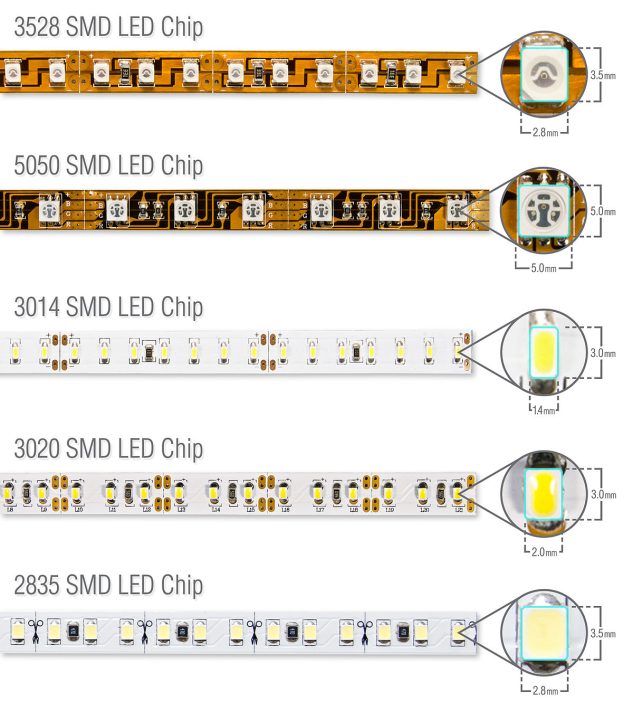
Two of the most popular types of LED light strips are 5050 and 2835. These two widths are among the most common on the market.
5050 LED strips are 10mm wide, while 2835 LED strips are 8mm wide. Both widths are quite popular, but 5050 is slightly more so. This is likely because 5050 strips offer a higher lumen output than 2835 strips.
It’s important to remember that width is just one factor to consider when choosing an LED strip. There are many other factors that will affect the performance of your light strips, such as length, lumen output, CRI, and color temperature.
Also read: How to Reset LED light remote at Home
When selecting LED light strips, understanding LED density differences between models, such as the popular 5050 and 2835 widths, can significantly impact the brightness and quality of light produced. While the common widths like 10mm and 8mm provide distinct aesthetic choices, it is essential to consider factors like wattage and color options to ensure the strip light products meet your specific lighting needs.
Final Insights on LED Light Strip Width Size Importance
In conclusion, understanding the width size of LED light strips is crucial for ensuring that they fit appropriately in the desired installation area and achieve the intended lighting effect. LED strips typically come in a variety of widths, with the most common sizes ranging from 8mm to 12mm. These dimensions are suited for different applications: narrower strips are ideal for subtle accent lighting in tight spaces, such as under cabinets or along bookshelves, while wider strips provide more robust lighting suitable for main lighting sources or outdoor applications where more coverage is necessary.
Moreover, the width of the LED strip not only affects where it can be installed but also influences the type of accessories and connectors that will be compatible with the strip. For instance, certain profiles and diffusers might only fit specific widths, and using the correct size ensures a seamless installation and optimal light diffusion. When planning a project that includes LED light strips, it is essential to measure the areas of installation accurately and compare these measurements with the specifications of the LED strips available. This foresight prevents common issues such as insufficient lighting for the intended area or mismatches with installation accessories. By paying close attention to the width and other specifications of LED light strips, users can enhance the aesthetic appeal and functionality of their lighting projects, resulting in beautifully illuminated spaces tailored to their specific needs.
What Is The Width Size Of LED Light Strip | Choosing the Right Width Size for Your LED Light Strip
Understanding what the width size of LED light strips means is essential for selecting the right option for your lighting project. LED strip widths typically range from 1 to 2 inches, with common variations including strips that emit white light, blue light, or RGB colors. The width directly affects the layout of the strip, with wider silicone diffusers providing better light distribution and minimizing harsh shadows. A strip light’s brightness, measured in actual light output or lm/ft, is influenced by the number of SMD LEDs per inch and their wattage, impacting areas like indoor and outdoor applications, including dining room or patio lighting. Choosing the right width can ensure optimal performance and longevity, allowing for a seamless integration into various settings, whether for a discrete accent or a bright statement piece.
What is the Width Size of LED Light Strip | Factors to Consider When Selecting LED Strip Width
Determining the right width for an LED light strip is crucial for maximizing its effectiveness in various applications. The width size of the LED light strip influences factors such as brightness and light dispersion. Common widths include 1-2 inches, with many products configured with 18-36 LEDs per meter. Thicker strips typically accommodate more LEDs per meter, resulting in higher light intensity. For specific lighting needs, such as kitchen or dining room lighting, understanding how width matters can help ensure the desired ambiance is achieved, whether that’s bright accent lighting or a soft glow.
Various widths of LED strips can significantly affect the overall performance and longevity of the product. A wider strip may house a greater number of emitters, leading to enhanced brightness and color rendering. Conversely, narrower strips may suit discreet lighting installations where lower power consumption is desirable. For projects that require flexibility in design, like beach lighting or accent features, selecting a width that matches the intended light effect is essential. The width of the strip, along with its manufacturing quality, helps shape the entire LED system’s efficiency and appearance, directly impacting its performance in any setting.
Applications and Uses for Different Width Sizes
Various strip widths in LED light strips can serve specific applications effectively. For instance, narrower strips, often used in indoor lighting applications, provide flexibility and fit seamlessly into tight spaces. These can be easily integrated into furniture or accent lighting areas. Conversely, wider strips are suitable for expansive projects, capable of delivering higher brightness thanks to a greater number of LEDs per foot. Such strips can replace traditional incandescent bulbs or fluorescent lamps for more energy-efficient solutions while maintaining high color and brightness specifications.
Different applications also influence the choice of width size based on desired effects. A wide silicone diffuser can help soften the output of brighter lights, ensuring even illumination for general lighting or task areas like kitchens. Color-changing LED strips can also vary in width, allowing for dynamic lighting designs that adapt to various moods or functions. The strip length and power consumption requirements must align with the spacing and layout of the installation to achieve optimal performance. Understanding what the width size of LED light strip means for your project can enhance both aesthetics and functionality.
Comparing Width Sizes of Various LED Light Strips
Understanding what the width size of LED light strips means is crucial for any LED strip project. The width can directly impact the strip brightness and the overall aesthetics of the installation. For instance, a strip with a wider PCB width often supports more individual LEDs, allowing for a greater density of light output, which is essential in applications like kitchen lighting or permanent lighting installations. The number of LEDs per foot (leds/ft) influences the power consumption, measured in watts/ft, which in turn affects the necessary power supply, particularly in low-voltage setups. Certain widths can also accommodate varying beam angles, enhancing the lighting effect in spacious areas. In strip light manufacturing, width variations cater to different strip light segments, ensuring diverse applications and needs, from color-changing to single color narrow fixtures. Understanding these aspects helps in choosing the right strip light wire and dimmable options, ensuring the product aligns with your design vision and practical requirements.
Differences Between Common LED Strip Width Sizes
Different widths for LED light strips play a crucial role in various applications and settings. The width size of LED light strips can affect how the light emits from the strip, influencing brightness and the overall visible spectrum. For example, a wider strip, such as one with the same PCB width of 12 mm, may offer more LED emitters per meter, leading to a greater output of light and a higher power draw. This is especially important for applications requiring high brightness, like task lighting or linear lighting installations. Knowing what the width size of LED light strip to choose can help ensure optimal performance in areas such as accent lighting or color-changing features.
When considering LED tape lights, different widths can dictate the type of dimming solutions compatible with the product. A strip light that is several inches wide might require a higher-capacity LED power supply to manage its power consumption effectively. Conversely, narrower strips may be more adaptable for smaller spaces, though the illumination level might be lower. Utilizing a low-voltage dimmer or a phase-cut wall-dimmer can enhance the functionality of the installation, allowing for effective control over brightness levels. Understanding the strip light longevity and the best practices for installation can lead to a successful and aesthetically pleasing outcome, reflecting the importance of choosing the right strip width for the desired length and application.
How Width Size Affects Brightness and Light Output
The width size of LED light strips significantly impacts brightness and light output. For instance, narrower strips may have fewer LEDs per meter, resulting in reduced light emission compared to wider options that contain a higher number of LEDs/m. This relationship is crucial in understanding the question, “What is the Width Size of LED Light Strip?” Wider lights strips are more likely to be able to produce brighter signals and can exhibit various colors, such as blue LED or white lights, depending on their manufacturing. Choices in strip width play a vital role in the overall lighting effect, whether it’s achieving a daylight look or creating a softer ambiance.
Variations in strip width also affect power consumption and compatibility with dimming systems. A wider strip often requires a more substantial LED power adapter to accommodate its higher strip light power needs. Conversely, narrow strips may use a standard dimmable power supply. The use of a wall-switch dimmer or a digital dimmer module can enhance the experience, especially for color-changing applications. When selecting the right strip, consider how the width matches your installation requirements. A spacious installation place may allow for wider strips, providing a robust emission of light that can effectively brighten larger areas without compromising the quality of light-producing products.
Installation Considerations for LED Light Strip Width
Understanding what is the width size of LED light strip is crucial for effective installation. The width of the strip can significantly affect the overall design and function of your led lighting setup. LED strips come in various widths, often measured in a few inches, and choosing the right size impacts not only aesthetics but also performance aspects like strip power consumption and whole strip emission. Wider strips might offer more light and better coverage, especially when using color changing options or bluer light. It’s essential to consider factors such as the led strip voltage, the height and placement of the diffuser cover, and the outputs of each strip segment to ensure uniform brightness across the installation. The appropriate width fosters a successful implementation of LED technology and ensures compatibility with a phase-cut dimmer approach, providing flexibility in the strip light color and intensity. Always consult strip light FAQs to clarify any uncertainties regarding specific products and their applications.
Best Practices for Installing Different Width Sizes
Understanding what is the width size of LED light strip is crucial for achieving the desired lighting effect. Different led strip products feature various strip widths, impacting how the light is emitted across a space. For instance, wider strips typically contain more led strip segments, allowing for a more even distribution of light. This becomes particularly important when using white lights, as it can reduce harsh contrasts where white lights fall off. Selecting the appropriate strip width matters to ensure that the aesthetic and functionality of the installation align.
Installation practices should take into account the specific strip width to optimize performance. A wider led strip may require stronger adhesive backing to secure it, while narrower strips can be more flexible, accommodating limited spaces. Understanding the manufacturing differences between led strips helps in selecting the right product for different applications. Ensuring that led strips of the same width are used together can create uniformity in light output, while mixing widths may lead to varied brightness levels and inconsistency in the strip emits.
Adapting Your Installation for Limited Space with LED Strips
Limited spaces often require careful planning to ensure that lighting remains effective and visually appealing. Understanding what the width size of LED light strip is essential for making the right choice. A narrower LED strip may fit where a wider version cannot while still providing adequate illumination. LED strips are manufactured in various widths, allowing for flexibility in installation, especially in tight areas. A white color LED strip can enhance small spaces by creating an illusion of brightness and depth.
Careful consideration of the environment is key to successful installation in confined areas. The term “LED strip” refers to the flexible circuit board that houses multiple LED lights, making it ideal for creative placements. Choosing the correct width not only affects the aesthetic but also the overall effectiveness of light output. Understanding what the width size of LED light strip you need will guide you in selecting the best option for your specific space requirements.
Conclusion
Understanding what the width size of LED light strip means is crucial for effective lighting design. The width of an LED strip can greatly affect its application, brightness, and overall aesthetic. Different widths are available in the LED strip manufacturing process, allowing for versatility in installation and use. By considering various factors such as space limitations and desired light output, you can make an informed decision on what width size of LED light strip will best suit your needs. This knowledge empowers you to select the ideal LED strip for any project while ensuring optimal performance and visual appeal.

